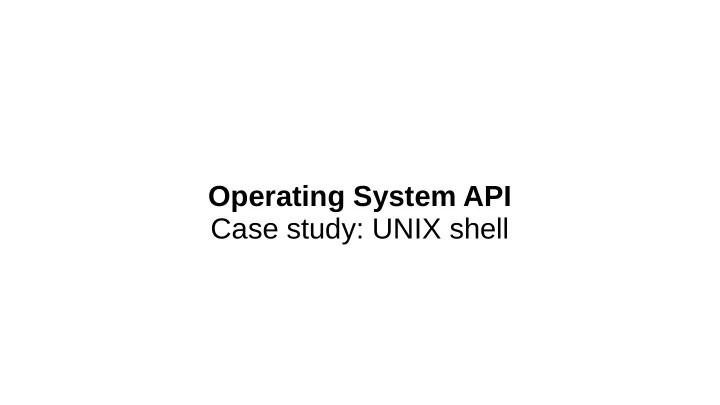

Operating System API Case study: UNIX shell
Unix shell ● Provides interactive command execution ● Was part of OS kernel initially, now a normal program ● The shell interface looks like this: $ _ Prompt Keyboard cursor
Unix shell $ cat foo.txt Command typed by user This is the content of Output of command – file foo.txt contents of file “foo.txt” $ _ Shell ready for another input
Unix shell: barebones code while (1) { write (1, “$ “, 2); // print “$ “ readcommand(command, args); // ... spawn new process and wait for it to finish }
Unix shell: barebones code while (1) { write (1, “$ “, 2); // print “$ “ readcommand(command, args); // ... spawn new process and wait for it to finish } write() syscall: write(fd, pointer, size) – write ‘size’ bytes pointed to by ‘pointer’ to file (or device) backed by file-descriptor ‘fd’.
Unix I/O facilities ● Set of syscalls: read, write, open, close ... ● fd = open(“filename”, ...); ● ‘fd’ is the “file descriptor” for the file – The OS maintains a table of open file descriptors for each process.
while (1) { write (1, “$ “, 2); readcommand(command, args); if ((pid = fork()) == 0) // create ‘copy’ // of this // process exec(command, args); // execute command else if (pid > 0) wait(0); else // handle error }
Unix process management facilities ● Set of syscalls: fork, exec, wait, exit, ... ● fork() creates a replica of current process – Both processses then continue execution from the next statement. Child – fork() returns 0 fork() Original Parent – fork() returns process pid of child pid => process identifier
Unix process management facilities ● Set of syscalls: fork, exec, wait, exit, ... ● fork() creates a replica of current process if ((pid = fork()) == 0) } exec(command, args); Child part else if (pid > 0) } Parent part wait(0);
Unix process management facilities ● Set of syscalls: fork, exec, wait, exit, ... ● fork() creates a replica of current process if ((pid = fork()) == 0) } exec(command, args); Child part else if (pid > 0) } Parent part wait(0); ● exec() executes program specified by command -- replacing the current process
Unix process management facilities if ((pid = fork()) == 0) } exec(command, args); Child part else if (pid > 0) } Parent part wait(0); ● exec() executes program specified by command -- replacing the current process ● wait() suspends the current process until the child calls exit()
Unix process management facilities ● fork() + exec() required for executing a new program ● Was somewhat simple to implement in those days ● Simple but enables other use cases – I/O redirection, pipes etc. ● Windows has CreateProcess() for the same job – 10 formal parameters ● Performance differences due to copy operation
More on Unix I/O facilities ● Each process has 3 OS provided file-descriptors open by default: – stdin (0), stdout (1), stderr (2) ● For programs started by shell: – stdin connected to keyboard – stdout connected to console – stderr (also) connected to console
Unix shell – I/O redirection $ ls > tmp1 $ cat tmp1 Desktop Documents Downloads Music Pictures Videos ● ‘>’ redirects output ( stdout) of ls to file tmp1 ● Very useful construct – shell essentially acting as a programming environment – Similar functionality would otherwise require changes to the program
Unix shell – I/O redirection ● ‘>’ for redirecting stdout ● ‘<’ for redirecting stdin ● ‘2>’ for redirecting stderr $ wc < tmp1 > tmp2 $ cat tmp2 1 6 50
Unix shell – I/O redirection implementation if ((pid = fork()) == 0) { // close default stdin close(0); open(stdin_filename); // close default stdout close(1); open(stdout_filename); exec(command, args); }
I/O redirection – Another example $ sh < tests.sh > out $ grep “fail” < out > fails $ wc -l < fails 1 $ rm out fails ● Executes commands in tests.sh, saving output to file out ● Search for “fail” in out , save the results in file fails ● Count the number of lines in fails
Introducing “pipe” $ sh < tests.sh > out $ grep “fail” < out > fails $ wc -l < fails 1 $ rm out fails Same solution using pipe “|” construct: $ sh < tests.sh | grep “fail” | wc -l
“pipe” -- overview input of ‘grep’ output of ‘sh’ pipe (stdin) (stdout) ● Unidirectional of data (bytes) from one process to another ● Kernel manages the flow
“pipe” -- syscall ● Signature: pipe(int[2]) ● Usage: int pfd[2]; pipe(pfd); ● pfd[0] – read end of pipe ● pfd[1] – write end of pipe
“pipe” -- inter-process communication (IPC) int pfd[2]; pipe(pfd); if ((pid = fork()) == 0) { write(pfd[1], “Hello from child”, 16); exit(0); } else (pid > 0) { sz = read(pfd[0], buf, 100); // blocks until write is executed by child write(1, buf, sz); wait(0); }
Questions?
Recommend
More recommend